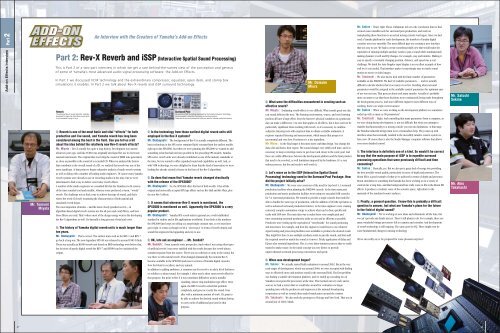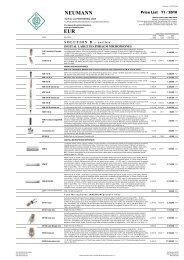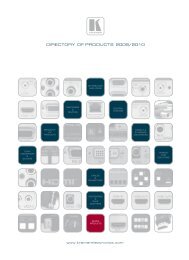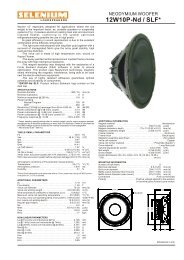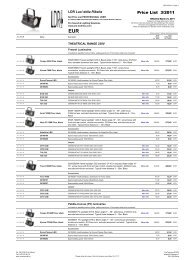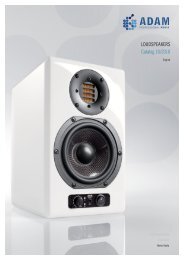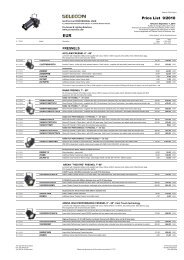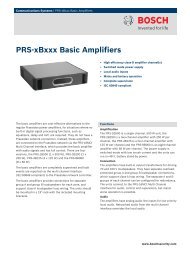Download - Yamaha Downloads
Download - Yamaha Downloads
Download - Yamaha Downloads
Create successful ePaper yourself
Turn your PDF publications into a flip-book with our unique Google optimized e-Paper software.
Add-on Effects Interview Part 2<br />
Mr. Tomomi<br />
Miyata<br />
An Interview with the Creators of <strong>Yamaha</strong>’s Add-on Effects<br />
Part 2: Rev-X Reverb and iSSP (Interactive Spatial Sound Processing)<br />
This is Part 2 of a two-part interview in which we get a rare behind-the-scenes view of the conception and genesis<br />
of some of <strong>Yamaha</strong>’s most advanced audio signal processing software: the Add-on Effects.<br />
In Part 1 we discussed VCM technology and the extraordinary compressor, equalizer, open deck, and stomp box<br />
simulations it enables. In Part 2 we talk about Rev-X reverb and iSSP surround technology.<br />
Reverb<br />
The advanced Rev-X reverb algorithm, originally<br />
developed for high-end stand-alone reverb units,<br />
is now available in plug-in form.<br />
Q: Reverb is one of the most basic and vital “effects” for both<br />
production and live sound, and <strong>Yamaha</strong> reverb has long been<br />
considered among the best in the field. Can you tell us a bit<br />
about the idea behind the relatively new Rev-X reverb effects?<br />
Mr. Miyata : Rev-X actually has quite a long history. Development was started<br />
about ten years ago, and like VCM it was originally developed for use in electronic<br />
musical instruments. The original idea was bring the sound of MIDI tone generators<br />
as close as possible to the sound of a recorded CD. When we analyzed the factors<br />
that contribute to the overall sound of a CD, we realized that reverb was one of the<br />
most significant. At that point we began exhaustive analysis of studio reverb systems<br />
as well as dialog with a number of leading studio engineers. Of course many <strong>Yamaha</strong><br />
reverb systems were already in use in recording studios at the time, but we were<br />
determined to find a way to deliver even better reverb effects.<br />
A number of the studio engineers we consulted felt that the <strong>Yamaha</strong> reverb systems<br />
of the time sounded cool and metallic, whereas some preferred a warm, “woody”<br />
reverb. The challenge was to find a way to achieve that type of sound, and that’s<br />
where the work of closely examining the characteristics of both natural and<br />
simulated reverb began.<br />
The most important elements – and the most closely guarded secrets – in<br />
algorithm-based digital reverb systems are the all-pass and comb filters, and how<br />
those filters are used. That’s where most of the design energy went in the developing<br />
the Rev-X algorithms as well. It’s basically a long process of trial and error.<br />
Q: The history of <strong>Yamaha</strong> digital reverb units is much longer than<br />
ten years.<br />
Mr. Okabayashi : That’s correct. The earliest units such as the REV-1 and REV-7<br />
go back a long way. The now-legendary SPX-90 was released in around 1985 I think.<br />
There was actually an R1000 reverb unit based on BBD technology even before that,<br />
but in terms of purely digital reverb the REV-7 and SPX90 can be considered the<br />
origins.<br />
Surround Post<br />
Revolutionary iSSP technology developed by the <strong>Yamaha</strong> Innovative Technology<br />
Division powers a selection of amazing surround processors.<br />
These are the surround production tools you need for ultimate control and realism.<br />
Q: Is the technology from those earliest digital reverb units still<br />
employed in the Rex-X systems?<br />
Mr. Okabayashi : The background of Rev-X is actually completely different. The<br />
basic technology in the SPX series remained fairly constant from the earliest models<br />
right up to the SPX2000, but when we were planning the SPX2000 we wanted to add<br />
something extra that had not been possible in the preceding SPX models. <strong>Yamaha</strong><br />
SPX-series reverb units were already established as one of the industry standards at<br />
the time, but we wanted to offer expanded sound and capabilities as well. And, as<br />
with VCM technology, we were delighted to learn that the kind of innovation we were<br />
looking for already existed in-house in the form of the Rev-X algorithms.<br />
Q: So does that mean that <strong>Yamaha</strong> reverb changed drastically<br />
with the release of the SPX2000?<br />
Mr. Okabayashi : No, the SPX2000 offers the best of both worlds. It has all the<br />
original and universally accepted SPX type effects such as Rev Hall and Rev Plate, plus<br />
the new Rev-X effects.<br />
Q. It seems that wherever Rev-X reverb is mentioned, the<br />
SPX2000 is mentioned as well. Apparently the SPX2000 is a very<br />
popular product.<br />
Mr. Okabayashi : <strong>Yamaha</strong> SPX reverb units in general are a well-established<br />
standard in studios and in life applications worldwide. If you look at the numbers<br />
the SPX2000 just keeps on selling at a surprisingly constant rate, so we must have<br />
got it right. It seems as though we hit a “sweet spot” in terms of reverb density and<br />
sound that engineers find appealing and easy to use.<br />
Q: OK, lets ask an engineer … Mr. Sendoh?<br />
Mr. Sendoh : From a purely sonic perspective, back when I was using other types<br />
of artificial reverb I was never satisfied with the results because the reverb always<br />
sounded separate from the source. There was no cohesion or unity to the sound, the<br />
way there is with natural reverb. That changed dramatically the moment Rev-X<br />
became available in the SPX2000 and newer versions of <strong>Yamaha</strong> digital consoles.<br />
Now the blend is excellent, and very natural.<br />
In addition to adding ambience, a common use for reverb is to add a bit of thickness<br />
or solidity to a drum sound, for example. I often used a short room reverb effect for<br />
that purpose, but prior to Rev-X it was sometimes difficult to avoid a metallic<br />
sounding, almost ring-modulation type effect. Once<br />
again, the REV-X reverbs solved that problem<br />
completely, and gave me exactly the sound I was<br />
after with a minimum amount of work. It’s great to<br />
be able to achieve the desired sound without having<br />
to carry racks of additional gear just for that<br />
purpose.<br />
Q: What were the difficulties encountered in creating such an<br />
effective reverb?<br />
Mr. Miyata : Evaluating reverb effects is very difficult. What sounds great one day<br />
can sound deficient the next. The listening environment, source, and even listening<br />
position all have a huge effect. Even the listener’s physical condition on a particular<br />
day can make a difference. I’m sure that applies to all effects, but it does seem to be<br />
particularly significant when working with reverb, so it’s necessary to combine<br />
subjective listening tests with empirical data to obtain a reliable evaluation. It<br />
requires repeated listening and measurement, which means that progress is<br />
incremental and very slow. Persistence is a key ingredient.<br />
Mr. Miura : In the final stages it becomes more craft that design. You change the<br />
data a bit and listen, then repeat. The sound changes very subtly each time, and it is<br />
necessary to keep correcting course to get closer and closer to the sonic goal. And<br />
there are subtle differences between the development platform and the final product<br />
that need to be resolved, as well limitations imposed by the hardware. It’s a very<br />
tedious process, but the end result is well worth it.<br />
Q: Let’s move on to the iSSP (Interactive Spatial Sound<br />
Processing) technology used in the Surround Post Package. How<br />
did the project initially arise?<br />
Mr. Okabayashi : We were very conscious of the need for top-level 5.1 surround<br />
production facilities when planning the DM2000 console. At the time many post<br />
production and music production facilities were using two cascaded 02R consoles<br />
for 5.1 surround production. We wanted to provide a single console that would be<br />
able to handle the same type of production, with the addition of 96 kHz operation as<br />
well as advanced surround production features. At the time engineers were creating<br />
extremely complex automation setups to achieve what can be done quickly and<br />
easily with iSSP now. The main idea was to make those very complicated and<br />
time-consuming surround production tasks as easy and as efficient as possible.<br />
Producers were writing up the equivalent of “storyboards” for sound positioning<br />
and movement, for example, and then the engineers would have to use whatever<br />
signal routing and processing facilities were available to produce the desired result.<br />
They might first have to use multiple auxiliary sends to pan the sound, and then add<br />
the required reverb to match the sound as it moves. Tricky application of delay and<br />
EQ are also essential ingredients. This is a very labor-intensive process that we really<br />
wanted to make easier. So the initial concept was very direct: to provide<br />
unprecedented surround processing convenience and speed.<br />
Q: When was development begun?<br />
Mr. Sekine : We actually started field evaluations in around 2002. But at the very<br />
early stages of development, which was around 2000, we were occupied with finding<br />
ways to effectively move and position sound in the surround field. The first problem<br />
was finding a suitable development platform, and we ended up cascading two of<br />
<strong>Yamaha</strong>’s most powerful processors at the time. That worked out very well, and as<br />
soon as we had a system that we could take around for evaluation we began<br />
spending time with the producers and engineers at the national broadcasting<br />
corporation as well as several other major broadcasters around the country.<br />
Mr. Takahashi : We also took the prototype to Chicago and New York. That was in<br />
around July of 2002 I think.<br />
Mr. Sekine : That’s right. Those evaluations led us to the conclusion that we had<br />
created some valuable tools for surround post-production, and work on<br />
transplanting those functions to an actual mixing console was begun. Since we had<br />
used a <strong>Yamaha</strong> platform for early development, the transfer to <strong>Yamaha</strong> digital<br />
consoles went very smoothly. The most difficult part was creating a user interface<br />
that was easy to use. We had to create something totally new that would make the<br />
equivalent of running multiple auxiliary sends to pan a sound while simultaneously<br />
making dynamic reverb and EQ changes, for example, easy and intuitive. Making it<br />
easy to specify a constantly changing position, distance, and speed was a real<br />
challenge. We think the Auto Doppler input display is an excellent example of how<br />
well we’ve succeeded. That interface makes it surprisingly easy to match sound<br />
motion to movie or video images.<br />
Mr. Takahashi : We also had to deal with the finite number of parameters<br />
available on the DM2000. We had 32 available parameters … and it’s actually<br />
difficult to decide whether that’s too many or too few. Deciding what surround<br />
parameters would be assigned to the available control parameters for optimum ease<br />
of use was not easy. That process alone took many months. Actually it’s probably<br />
more accurate to say that those decisions were continuously being made throughout<br />
the development process. And since different engineers have different ways of<br />
working, there’s no single correct answer.<br />
Mr. Sekine : When we were working on the development platform we sometimes<br />
ended up with as many as 90 parameters!<br />
Mr. Takahashi : Right. And controlling that many parameters from a computer, as<br />
we were doing during development, is not too difficult. But when you attempt to<br />
transfer that functionality to a mixing console you run into limitations. At that stage<br />
the <strong>Yamaha</strong> industrial design team were a tremendous help. They came up with<br />
interface ideas that eventually resulted in the incredibly intuitive control system we<br />
have now. Of course there’s also the Studio Manager computer software that allows<br />
even more detailed control.<br />
Q: The interface is definitely one of a kind. So would it be correct<br />
to say that the main purpose of iSSP is to expedite surround<br />
processing operations that were previously difficult and time<br />
consuming?<br />
Mr. Sekine : Basically, yes. But we also put a great deal of energy into providing<br />
the best possible sound quality, particularly in terms of depth and presence. The<br />
Room ER is a good example of what we’ve achieved in terms of depth and presence.<br />
Room simulation is something that <strong>Yamaha</strong> has been working on in a variety of<br />
contexts for a long time, and that background has really come to life in the Room ER<br />
effects. It produces a realistic sense of the acoustic space, right down to the<br />
materials of the simulated room’s surfaces.<br />
Q: Finally, a general question. I know this is probably a difficult<br />
question to answer, but what are <strong>Yamaha</strong>’s plans for the future<br />
in the field of digital sound?<br />
Mr. Okabayashi : We’re working on new ideas and refinements all the time, but<br />
we can’t provide any details just yet. There’s still plenty to do. For example, there are<br />
many wonderful vintage processors left to examine and consider. And development<br />
of reverb technology is still ongoing. The same goes for EQ. There might even be<br />
some fundamental changes in mixing technology.<br />
All we can really say is: be prepared for some pleasant surprises!<br />
47 48<br />
Mr. Daisuke<br />
Miura<br />
Mr. Satoshi<br />
Sekine<br />
Mr. Akio<br />
Takahashi


